
Frik n’ Frak
I have spent a lot of keyboard time over the years providing review of various Rock Island Armory (ARMSCOR) 1911–based pistols. One of those pistols, the RIA 1911 FS Tactical has been my constant companion for some time now.
When the RIA ‘Ultra’ series came on the scene, I really did not pay a lot of attention to them. After all, they were just another RIA 1911-based pistol with a few more features than with the RIA 1911 FS Tactical. However, I was in the mood for another 1911-based, full-size pistol and started doing some research on a variety of products. These products included Colt, Kimber, Smith & Wesson, and even Dan Wesson. Of these products, the Colt Combat Commander was paused at. Having carried a Colt Combat Commander in a previous life time, I was drawn to it once again. However, the pistol that I was looking for was to become a daily carrier, a replacement for my RIA 1911 FS Tactical, and one that I would not mind showing daily wear and tear. Also, my budget disallowed me from owning a ‘top-of-the-line’ 1911. Actually I could afford one, but my frugal self took over, and I looked at the Rock Island Armory line-up once again.
Some consider the RIA line as ‘entry-level’ pistols and would never be a pistol that they would carry for defense of self or others. I would say that those folks need to drop their bias and look at the RIA series of 1911-based pistols in a different light. Priced a lot less than most 1911-based pistols, you get a pistol that you can bet your life on. And, I do bet my life on one or more of these pistols.
If you haven’t done your research, Armscor is an ISO 9001 certified compliant company which manufactures weapons using CNC (Computer Numerical Control) equipment. That says something about the company and the products they produce. Rock Island Armory 1911-based pistols, as with other firearms, carry a lifetime warranty and they are a pleasure to work with if you have a problem with any of their products. Also, the company is headquartered in Marikina, Philippines and represented in the United States by its subsidiary Armscor International, Inc, located in Pahrump, Nevada with facilities in Stevensville, Montana. This means that if you have an issue with their products, you ship it within the U.S. And, they are more than happy to converse with you on the phone. I have had one occasion to use their customer service and I came away from a pleasurable experience.
So, I now have the RIA ULTRA 1911A1 FS TAC II (Frik) and ULTRA 1911A1 MS TAC II (Frak) pistol in .45 ACP.

Fully-Adjustable Low Profile 2-Dot Rear Sight, Fiber Optic Front Sight, and G10 Grip Panels.
The RIA ‘Ultra’ line of pistols adds a few enhancements over the “Rock” standard tactical series of pistols (herein referred to as TAC I; whereas, the Ultra will be referred to as the TAC II). For example, my RIA 1911 TAC I has a ‘post’ front sight and a NOVAK-style fixed rear sight with no dots. The TAC II versions have fiber-optic front sights with a fully adjustable 2-dot rear sight. My RIA 1911 FS TAC I came with plastic grip panels that were quickly changed out to the Hogue Rubber finger-groove grip. The TAC II comes with G10 grip panels (that seem to be LOK Grips). The RIA 1911 FS TAC I uses a standard 7-round magazine. The TAC II uses an 8-round magazine with a beveled-magwell extension.

Magwell Extender for 8-Round Magazines
Other than those items, the TAC I and TAC II pistols are identical with two other exceptions. First, the RIA ULTRA 1911A1 FS TAC II has a magwell adapter that extends slightly below the frame. This magwell adapter may very well be the (Wilson Combat Custom Magazine Well 1911 (https://www.midwayusa.com/product/1070138050/wilson-combat-custom-magazine-well-1911). This extender is flared to assist in inserting a magazine into the magwell. While it does extend the frame a bit, an 8-round magazine, such as those from MEC-GAR, Wilson Combat, and others is flush-fit with the frame. The second exception is the aluminum main-spring housing rather than the plastic one that is used on the RIA 1911 FS TAC I (and on most 1911 pistols these days with Ruger being one exception).
Neither pistol is lightweight. The TAC II MS and FS are all-steel pistols with the TAC II FS weighing in at 2.87 pounds loaded and the TAC II MS coming in at 2.73 pounds loaded. These pistols definitely call for a good holster and support system if they are going to be carried.
Both pistols have a Parkerized finish. The Parkerized finish is not award-winning at all, but nonetheless, does protect the pistols. Both TAC I and TAC II pistols have a full-length guide rod (FLGR). With that said, several differences exist between the TAC II FS and TAC II MS pistols in regard to FLGRs.
The TAC II FS (Government) can be disassembled similar to any other standard 1911-based pistol. A bushing wrench is used to compress the guide rod bushing and release the barrel bushing from its locked position. Then, and while slowly releasing the tension on the guide rod bushing with the bushing wrench, the guide rod bushing and recoil spring can be removed from the pistol. The slide can then be removed in the normal manner. I; however, prefer a different method for disassembly, and it does not require a bushing wrench. With the hammer to the rear, I simply push the slide to the disassembly notch. While holding the slide in this position with my right hand, I remove the slide lock with my left hand. Then, while maintaining a tight grasp on the slide and the rear of the frame, I slowly allow the slide to move forward until no more recoil spring resistance is felt. Then, it is a simple matter of sliding the slide off of the frame. The tension on the recoil spring is very little at this point, and I can remove the guide rod bushing easily. I use the same technique when assembling the pistol. With the guide rod, recoil spring, and guide rod bushing in place, I simply slide the slide back onto the frame enough to line up the slide lock pin with the swing link, push the slide lock inward slightly, and push the slide rearward until the notch in the slide aligns with the slide stop. As with disassembly, I have a good hold on the slide and rear of the frame. Then, it is a simple matter of pushing the slide stop home until it is seated without any “Idiot Tracks.”
Disassembling the TAC II MS (Commander); however, is slightly different in that there is no barrel bushing to remove. There is a guide rod bushing, but it must come out toward the rear of the pistol. I remove the slide from the frame the same way as I did for the TAC II FS. When the slide if off of the frame, the guide rod must be compressed until a hole in the guide rod is past the guide rod bushing. I normally just push the guide rod forward with my strong hand while supporting the slide. Then, I insert a bent paper clip into the hole in the guide rod to lock the guide rod into a compressed condition. The guide rod and guide rod bushing “assembly” is then removed toward the rear of the pistol. The guide rod bushing can only be inserted into the frame one way.
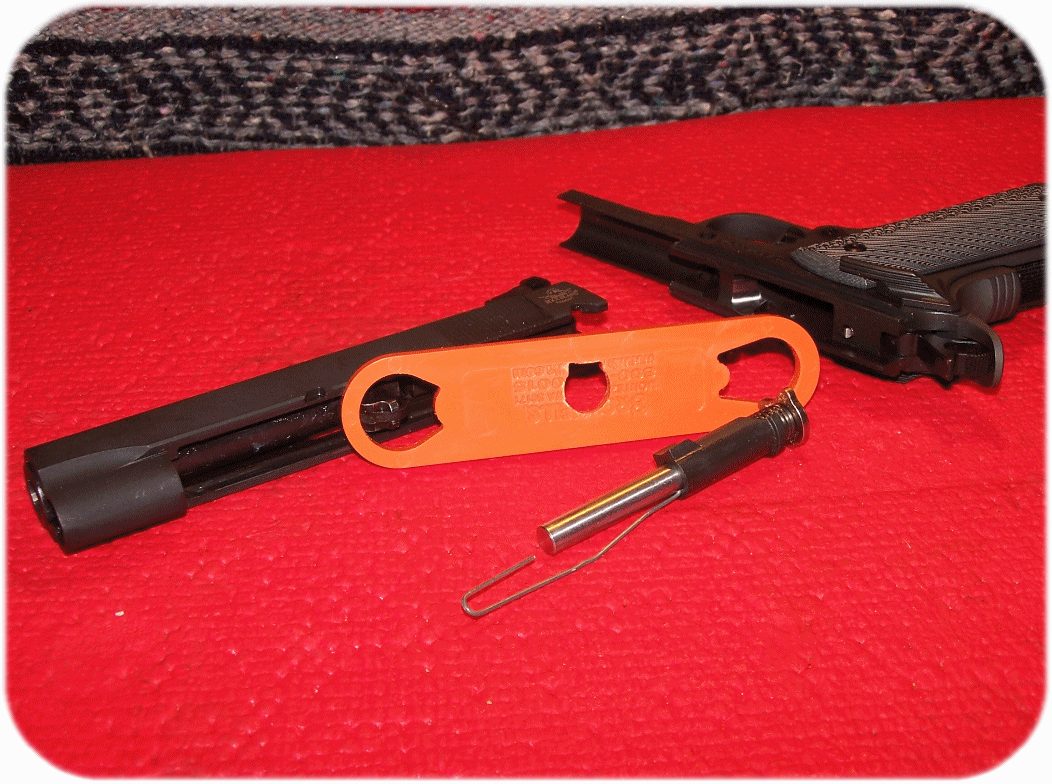
Bushing Wrench Adaptation for Assembly/Disassembly of TAC II Guide Rod “Assemblies.”
To allow for the guide rod and bushing “assembly,” I had to modify an already modified polymer bushing wrench. Other guide rod bushings of this tube were simply round and a simple hole drilled through the bushing wrench worked just fine. The guide rod bushing in the TAC II was slightly different; it incorporates an “index” tab to keep the guide rod bushing “indexed” within the slide. A notch was filed in the “guide rod bushing” hole previously drilled that allowed me to slide the TAC II’s guide rod “assembly” fully into it and allow me to assemble or disassembly the assembly. With this modification, I can easily disassemble the guide rod assembly for cleaning and lubrication, and just as easily assemble the guide rod, recoil spring, and guide rod bushing.
Assembling the TAC II MS is accomplished in two ways:
Way 1.
- Insert the guide rod assembly into the slide.
- Leave the paper clip in to keep the guide rod spring compressed.
- Assemble the slide and frame.
- Insert the slide lock as normal.
- Press the slide until you can engage the slide lock.
- Remove the paper clip.
- While holding the slide, press the slide lock to release the slide.
- Lower the slide as you normally would.
- Check for proper slide operation.
Way 2.
- Insert the guide rod assembly into the slide.
- Compress the recoil spring.
- While pressing the base of the guide, remove the paper clip in the guide rod.
- Slowly remove recoil spring pressure and allow the guide rod to butt against the swing link assembly.
- While pushing upward on the guide rod, assemble the slide to the frame.
- Push the slide rearward to line up swing link with the slide lock hole.
- Partially insert the slide lock.
- Push slide rearward until the disassembly/assembly notch is properly aligned.
- Insert the slide stop assembly.
- Slowly allow the slide to go forward.
- Check for proper slide operation.
Allow me to go back to the grip panels a bit. I find the G10 grip panels that came with the TAC II a bit too harsh for me. After all, I do have delicate writer’s hands. The G10 grip panels that come with the pistol are thick enough and comfortable in my hand – to a point. After about fifty rounds of .45 ACP, I long for a better grip. While I prefer the Hogue rubber finger-groove grips to most, I would have to do my usual ‘surgery’ for the “Rock Island Ambidextrous Safety’ cutout on the right side grip panel. This ‘cutout’ is something that I have to carve into the Hogue grip. If you are not familiar with the RIA method of providing an ambidextrous safety lever, let me just say that it is against conventional methods.
I would also have to create a ‘channel’ in each side of the grip in which the grip extender would reside. The G10 (which seem to be LOK Grips) grip panels that come with the pistol really need a layer of clothing between them and the body, in my opinion. With that said, I am starting to get used to them and they may remain on the pistol after all.
Getting back to the pistol itself, the quality is not what you would expect from a ‘low-end’ pistol. It is, in fact, slightly impressive. The slide to frame fit is excellent, the Parkerized finish is evenly applied for the most part, and I did not observe any tool marks except where you expect them in a 1911-based pistol. The barrel bushing to barrel fit is tight and the barrel bushing to slide is just as tight. You will need a bushing wrench to take this pistol down when new.
Some folks have something against the FLGR. In several cases; however, I have seen improvements in accuracy in my pistols as well as the pistols owned by others when using a FLGR. A FGLR has improved the accuracy of my Ruger SR 1911 CMD in 9mm and also one of my rotational carries, the Ruger SR 1911CMD-A in .45ACP. A shooting companion tried one in his old 1911A1 pistol and noted a difference in accuracy (I also sold him on the Hogue rubber finger-groove grip for his old war-horse).
Regardless, all RIA 1911-based pistols FS type come with a FLGR, but you can always swap it out for a ‘conventional’ guide rod and bushing for a very reasonable price. The MS and CCO also come with FLGRs but since these pistols are “bull-barreled” and do not have a barrel bushing, you are pretty much stuck with what you get. Note that this is not uncommon with some “Commander” and “Officer” versions of the 1911-based pistol, with one exception of the Ruger 1911CMD and 1911CMDA line of pistols that do use a conventional barrel bushing and standard guide rod.
I like the latest offerings from RIA. My RIA 1911 FS TAC I, the EDC, is what I would call a “Second” generation pistol in that the left side of the slide has the “Billboard’” that is a common complaint among many. I really don’t care, personally, as it shoots just fine. However, the latest RIA line-up has done away with the billboard and there is only a simple logo at the rear of the slide – similar to where Colt places the horse on their line of 1911-based pistols. Let’s just say that the latest RIA lineup is more aesthetically pleasing the previous versions.
When it comes down to it, the place any of this matters is when shooting the darn thing. On my RIA 1911 FS TAC I, which is my current EDC, I had to file down the front sight a tad to bring the impacts on the target up. With the RIA ULTRA 1911A1 FS TAC II and ULTRA 1911A1 MS TAC II , a fully adjustable (for windage and elevation) makes sight corrections a snap. With that said, the pistol was spot on at 10 yards and no adjustment was necessary for the rounds to impact the target where I wanted (or as close as I can get them).
The fiber optic front sight and two-dot adjustable rear sight is a far cry better than the sights on my EDC. Remember; however, this is not a target pistol, but having a low-profile adjustable rear sight is sure nice to have. At my age, I need all of the help that I can get.
If I was forced to classify the RIA ULTRA 1911A1 FS TAC II, or any (Armscor) Rock Island Armory 1911-based pistol, it would be an “Every-Day Man’s Working Pistol.” At half the cost, the Rock Island does everything just as well as it’s more refined brothers. As far as function, I can not find a single fault. It does exactly what it is supposed to do and very well. If you are looking for a trophy weapon to display in a case, the RIA is probably not for you. If you are looking for a wallet friendly, feature-filled 1911 that can hold its’ own, look no further.
Whether you are looking for your first 1911 pistol to evaluate the platform, or are adding a 1911- based pistol for carry, a home defense pistol, or competition, you might want to check out the RIA line-up. For some reason, I keep going back to them for my pistol needs and wants due to the quality and price of their 1911-based products.
So, you don’t like the .45 ACP? Well “Bibby” the ‘Rock” 1911-based pistols are also available in 9mm, .40 Smith and Wesson, 10mm. They also come in various sizes, configurations, and capacities. I can tell you that the 9mm version is one sweet shooter. I am not willing to invest in a .40 Smith & Wesson version, or a 10mm version just to produce a review for you. Well, maybe – later possibly.
Specifications for the Rock Island Armory (ARMSCOR) Rock Ultra 1911A1 (TAC II) FS and MS are shown below.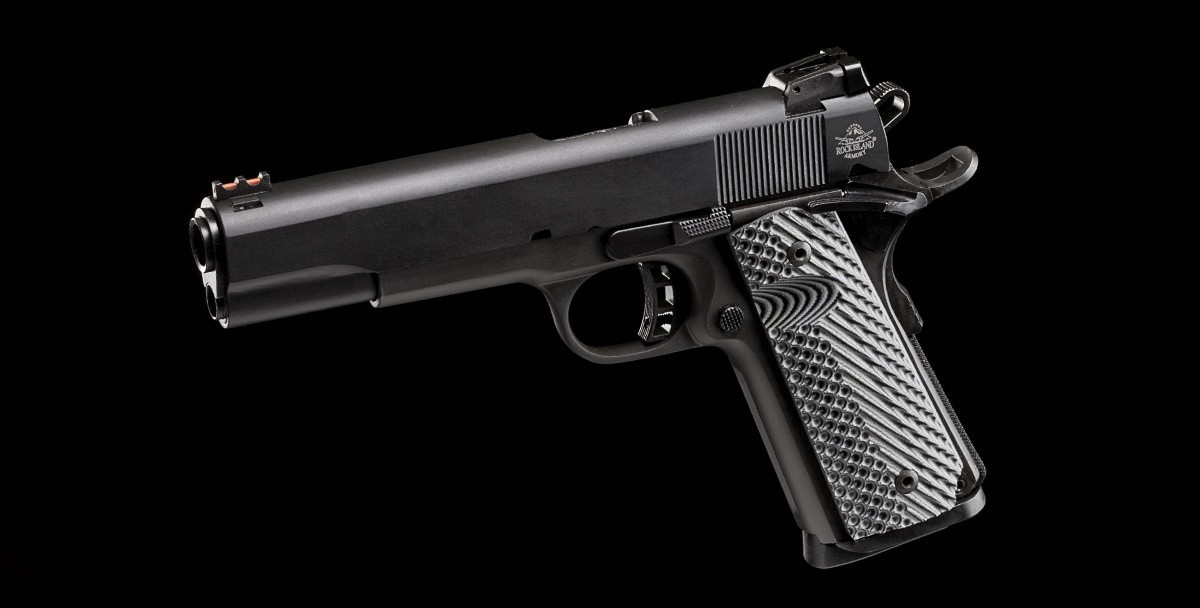
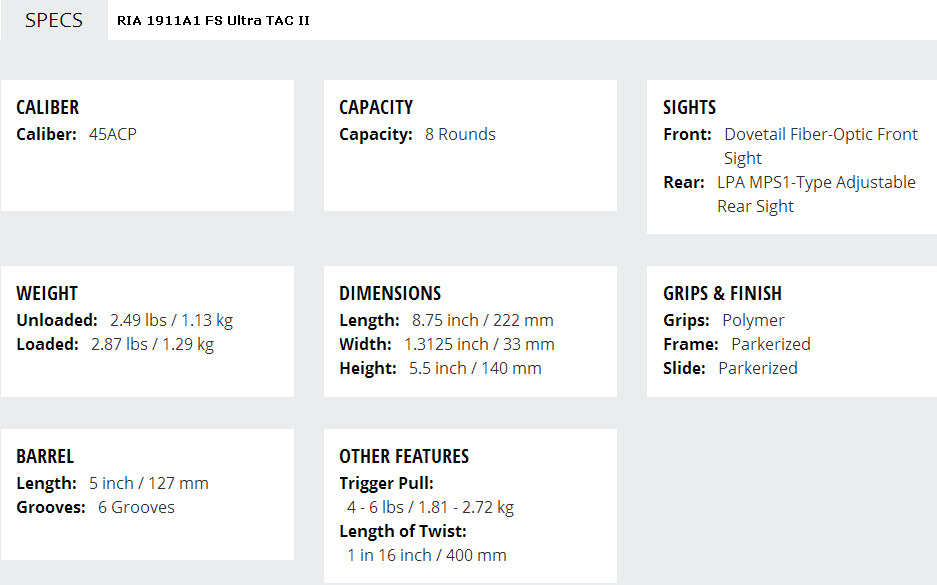
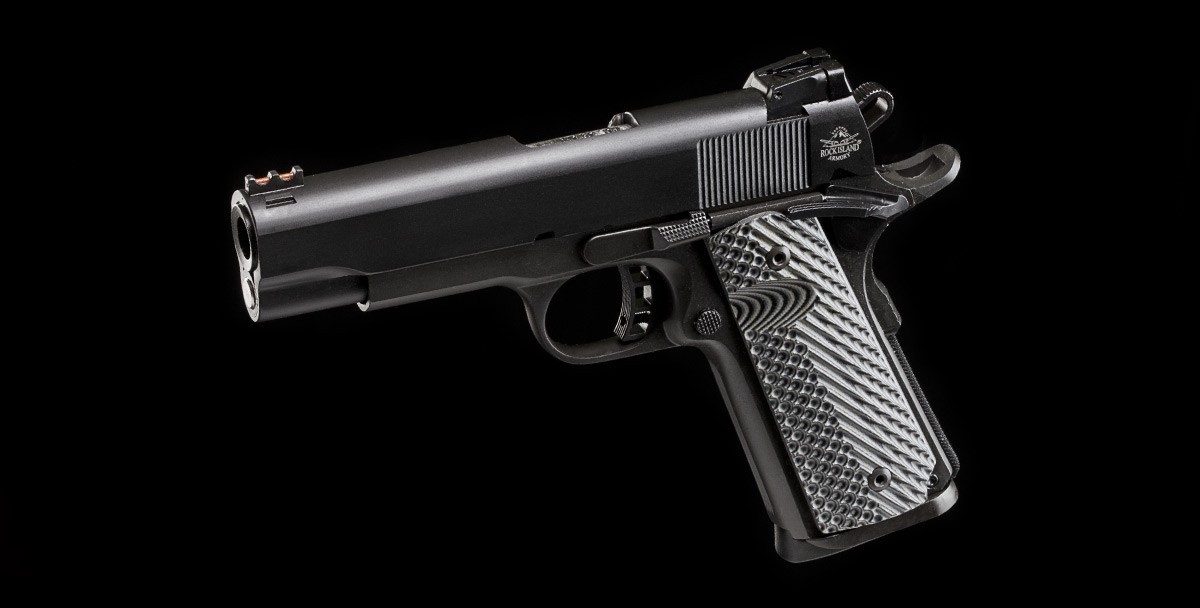
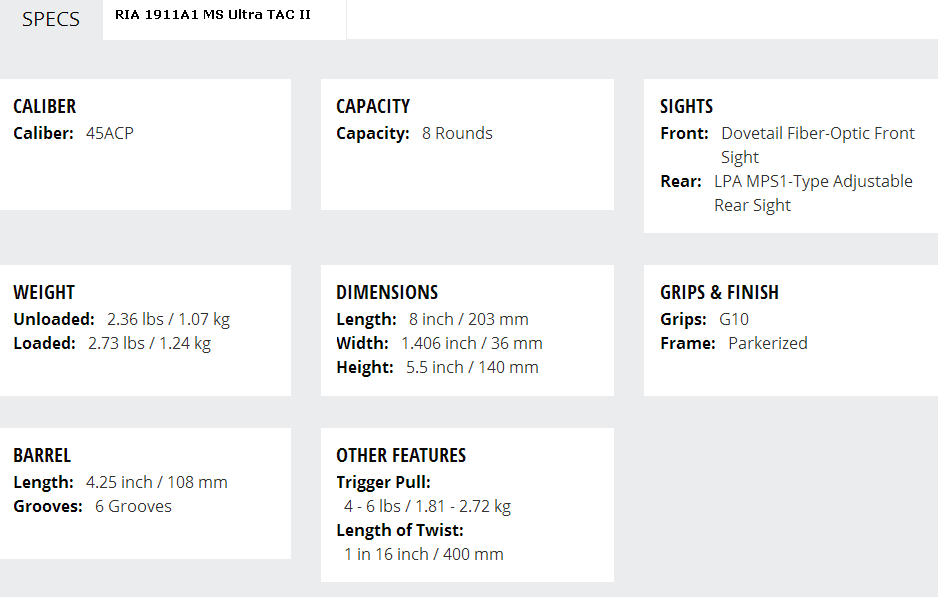
RESOURCES
Rock Island Armory (ARMSCOR) Rock Ultra 1911A1 (TAC II) FS: http://armscor.com/firearms/ria/rock-series/rock-ultra-fs-45-acp/
Rock Island Armory (ARMSCOR) Rock Ultra 1911A1 (TAC II) MS: http://armscor.com/firearms/ria/rock-series/rock-ultra-ms-45-acp/
![]()

